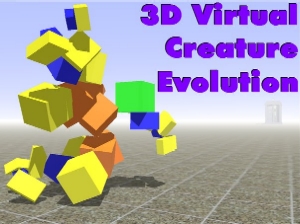3D Virtual Creature Evolution

3D Virtual Creature Evolution title image displaying a screenshot of a creature.
|
|
| Developer(s) | Lee Graham |
|---|---|
| Platform | Microsoft Windows, Linux |
| Available in | English |
| Type | Simulation |
| Website | http://www.stellaralchemy.com/lee/virtual_creatures.php (currently down, the software can be obtained from http://mediafire.com//?s71k1ri6xo28qri) |
3D Virtual Creature Evolution, abbreviated to 3DVCE, is an artificial evolution simulation program created by Lee Graham. The website is currently down. Its purpose is to visualize and research common themes in body plans and strategies to achieve a fitness function of the artificial organisms generated and maintained by the system in their given environment. The program was inspired by Karl Sims’ 1994 artificial evolution program, Evolved Virtual Creatures. The program is run through volunteers who download the program from the home website and return information from completed simulations. It is currently only available on Windows and in some cases Linux.
3DVCE uses evolutionary algorithms to simulate evolution. The user sets the body plan restrictions (maximum number of segment types, branching segments’ length and depth limits, and size limits) and whether fitness score is scaled in relation to size. Limb interpenetration is also an option. Reproduction / population settings include the size of each population and their run time (how long each individual has to attain a fitness score), percentage of individuals who get to reproduce (tournament size), what percentage sexually or asexually reproduce, and selection type is then determined. Crossover rate determines what percentage of an individual is created via crossover of parents and mutation. Mutation rate in body and brain is then determined. Specific mathematical operations and values can be attributed to the creature’s brain as well.
Fitness function is then determined. Artificial organisms’ fitness score is determined by how well they achieve their fitness goal within their evaluation time. Fitness functions include distance traveled, maximum height, average height, “TOG” (determined by amount of time creature is in contact with ground), and “Sphere” (determined by creature’s ability to catch and hold spheres). These goals are not individualized and can be set to specific strengths (from zero, as not having an influence on fitness, to one, or having maximum influence) to determine the fitness goal. What generations the fitness function applies to can also be set. The environment, or “Terrain”, is then determined. This includes a flat plain, bumpy terrain (in which a hill is generated around creature that constantly inclines as distance is traveled from the creature’s spawning point), water (a low gravity simulator, non-functional), and “spheres” (spheres are generated above creature to catch).
...
Wikipedia
